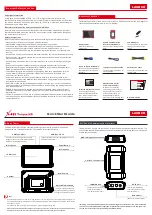
Scope and Multimeter Operations
Control Panel and Settings
118
9.9.7 Filter Icon
Depending on which function it is used with, Filter can minimize or smooth
out signal spikes and fast variations, when the signal is disrupted by noise
or other interference.
Filter - Lab Scope
Using the filter with the lab scope, smooths out fast spikes, which helps to provide
a good balance between noise suppression and signal integrity.
Using the filter is useful when working with scales of 5 volts and below, as the lower
the voltage scale, the more likely noise can occur.
Example:
Using the filter is helpful when testing components such as, an O2
sensor (1or 2 volt scale), or when performing a throttle position (TP) sensor
sweep test (5 volt scale).
In addition, the filter is also helpful for low amp probe tests, as a low voltage scale
is used to measure the output of the probe (due to the conversion factors of the
probe).
Example:
For a probe with a conversion factor of 100 mV/A connected to a 2
amp load, the scope uses a 200 mV scale to measure the output of the probe.
The scope converts the measured output to 2 amps for display on the screen.
Filter - GMM
Using the filter with the GMM minimizes noise by ignoring or smoothing out fast
signal spikes.
•
For a direct measurement test, such as volts, amps, or pressure, the filter
minimizes the display of very fast spikes by averaging the sampled data when
filter is active.
•
For a calculated measurement test, such as frequency, pulse width, dwell, or
duty cycle, extremely fast spikes (20 µS and faster) from sources like the
ignition system are ignored when filter is active.
9.9.8 Invert Icon
Invert is used to switch signal polarity, so the trace appears upside down
(inverted) on the screen. This is typically used when measuring amperage
using the low amp probe, or high-voltage signals like secondary ignition.
Example:
A signal that normally rises from 0 to +5 volts, if inverted would
show falling from 0 to –5 volts.
9.9.9 Coupling AC Icon
Coupling AC subtracts the average value of a signal so that small
variations can be seen in the waveform. This is accomplished by blocking
the direct current (DC) portions of a signal in order to amplify (show) the alternating
current (AC) portions of the signal, without driving the trace off of the screen.
Using coupling AC can be helpful when testing and diagnosing alternator ripple or
fuel pump amperage, by allowing you to see any abnormal small variations or
events.
Filter Icons
On (Interference is suppressed)
Off (Interference is not suppressed)
Invert Icons
On (Polarity is inverted)
Off (Polarity is not inverted)
Coupling AC Icons
On (DC signal portion blocked)
Off (DC signal portion not blocked)
Содержание Zeus
Страница 1: ...User Manual ZEEMS342A Rev F TM Start BC ...
















































